Numbat (WA)

This is part of my Australian State and Territory emblem series where I nature journal the floral, bird, mammal and marine emblems.
Scientific name: Myrmecobius fasciatus
Noongar: Noombat (or walpurti in the Pitjantjatjara dialect)
The faunal emblem for Western Australia is the undeniably cute and sadly endangered numbat. Once widespread throughout southern Australia, their range is now greatly reduced - mostly restricted to Dryandra Woodland and Perup Nature Reserve, in Western Australia.
With a population estimated* to be less than 1000, these marsupials are rarer than giant pandas or black rhinos. Habitat loss and introduced predators such as foxes and feral cats are the major cause of their decline, which began with Europeans' arrival. Recently there have been efforts to re-introduce them to South Australia and New South Wales.
*A 2022 article suggests a population density in the Upper Warren area (the largest natural population of the numbat) to now be ~1900, based on remote sensor camera traps data.
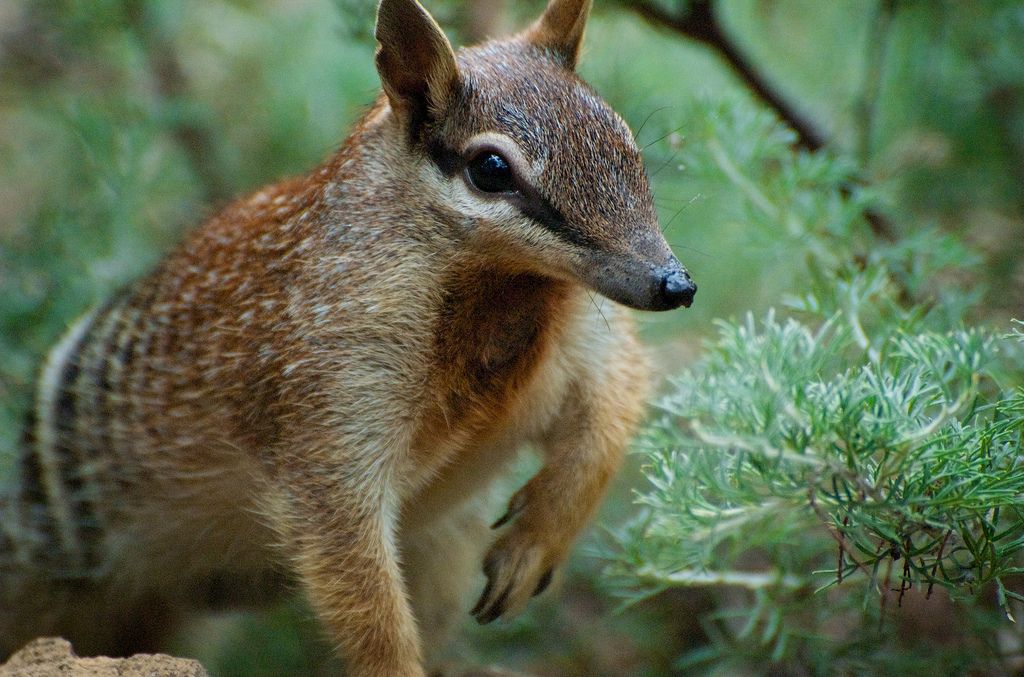
These beautifully striped, small creatures have a bushy tail that's almost as long as their body, measuring up to a total length of only 35-45 cm. They also have a long, finely-pointed snout and a distinctive black eye stripe that runs from their nose to the base of the ears. Numbats' colourations can vary from a reddish-brown to a soft grey with between four and eleven white stripes on their hindquarters.
They are termitivorous (termite eaters) so have incredibly long tongues coated with sticky saliva. Numbats prefer eucalypt woodland such as jarrah and wandoo, where they can shelter and nest in hollow logs as well as be close to their termite meals. Natural predators of the numbat include reptiles and raptors.
I notice, I wonder, it reminds me of...
My first glimpse of a numbat was a grey blur in my peripheral vision. It was the bushy tail of a female scampering away up the path of the Arboretum in Dryandra.

I followed her to a hollow log where she was hiding. They are smaller than I expected, twitchy (nervous creatures?) evident from a shaky paw, but perhaps that was just fear at the moment.
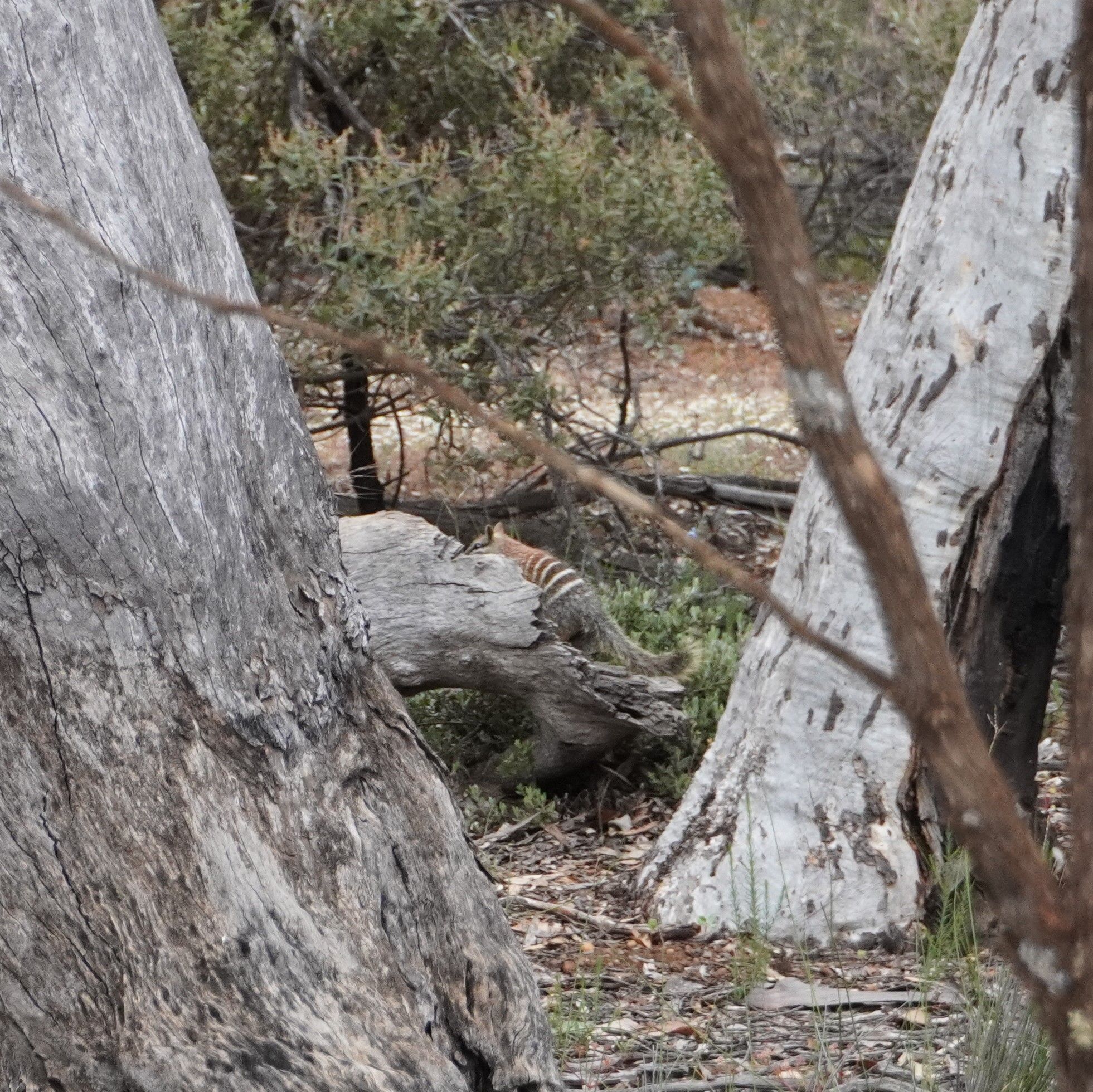
As I waited patiently for her to leave the safety of the log I studied her little triangular ear, "rusty red-brown" except for a white border on the tip. A couple of times she yawned and snapped up a few termites from the log, so I was able to see her long, thin, pink tongue. It made me wonder how many termites numbats eat in a day (20 000 on average 🤯) if they eat anything else (not really) and how the weather could have an effect on termite activity.
After some time she was confident enough to sit on top of the log, showing off her 5 beautiful stripes on the lower haunches. These help camouflage the numbat as it forages during the day, allowing it to blend in with the surrounding grass using disruptive colouration. I certainly found them difficult to track when they were running away from me. Does their eye stripe also serve to camouflage I wonder? Perhaps for when they peek out of logs?
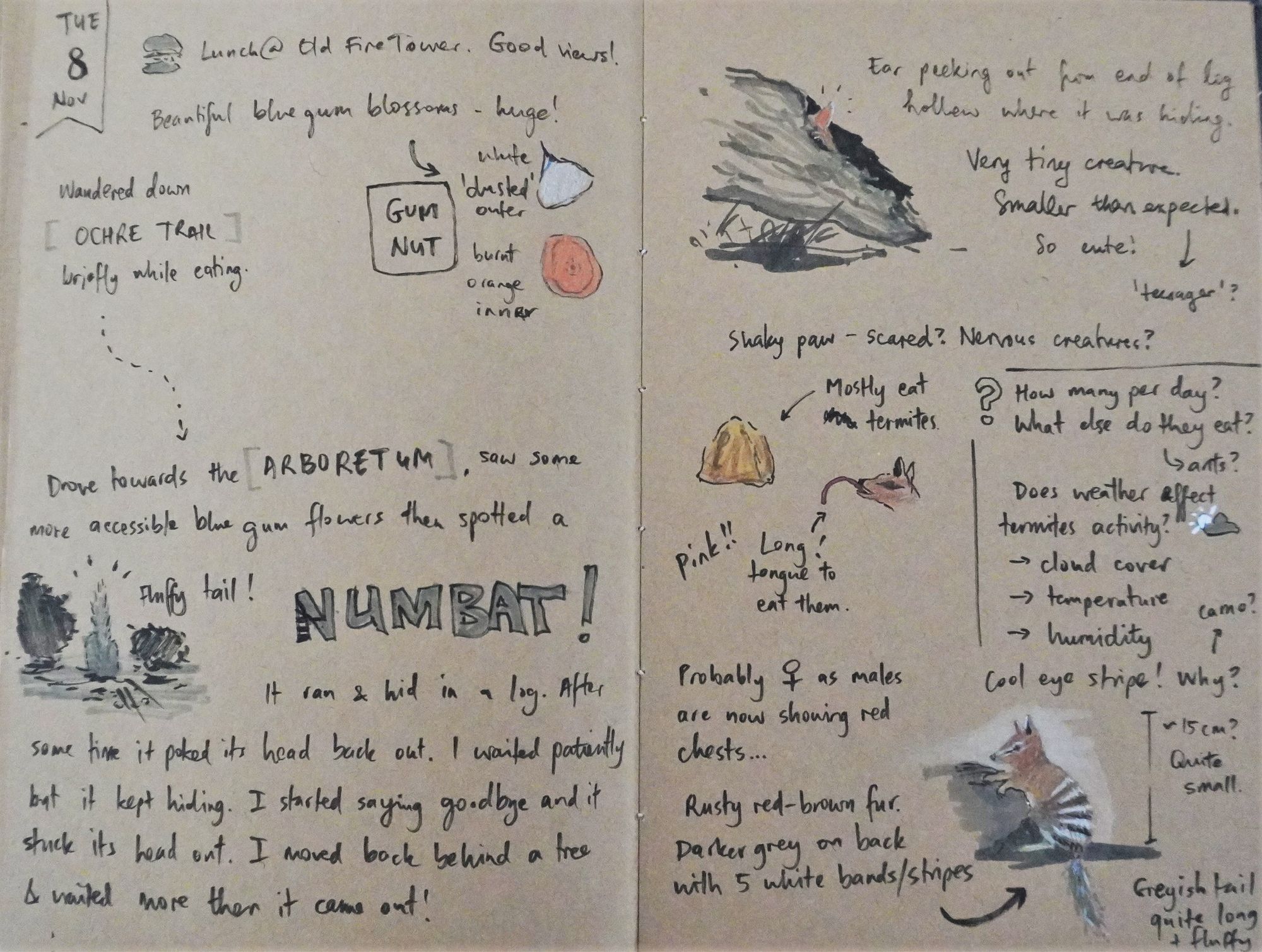

The next day I encountered my second wild numbat while we were touring along Darwinia Drive. Once again we were lucky that it was close to the road and standing up on a large log. This time it was clearly a male with his tell-tale red chest (stained due to an oily secretion from the sternal gland in the lead-up to mating season). He ran off into the distance amongst some more fallen logs and we couldn't spot him again.
They remind me of squirrels and cats in their furtive movements and can freeze spectacularly, holding their pose for a long time so as to not catch attention. Their jerky movements also serve to disrupt predators' sight of them. Sitting up on the logs their posture resembles a meerkat, but more statuesque.
Quick Facts
- Numbats are in the carnivorous marsupials order Dasyuromorphia, alongside quolls and Tasmanian devils. However, they're more closely related to the now-extinct thylacine (Tasmanian tiger).
- Despite the numbat's other name being the banded anteater they don't seem to intentionally eat ants, depending mostly on termites, of which on average they eat about 20 000 a day.
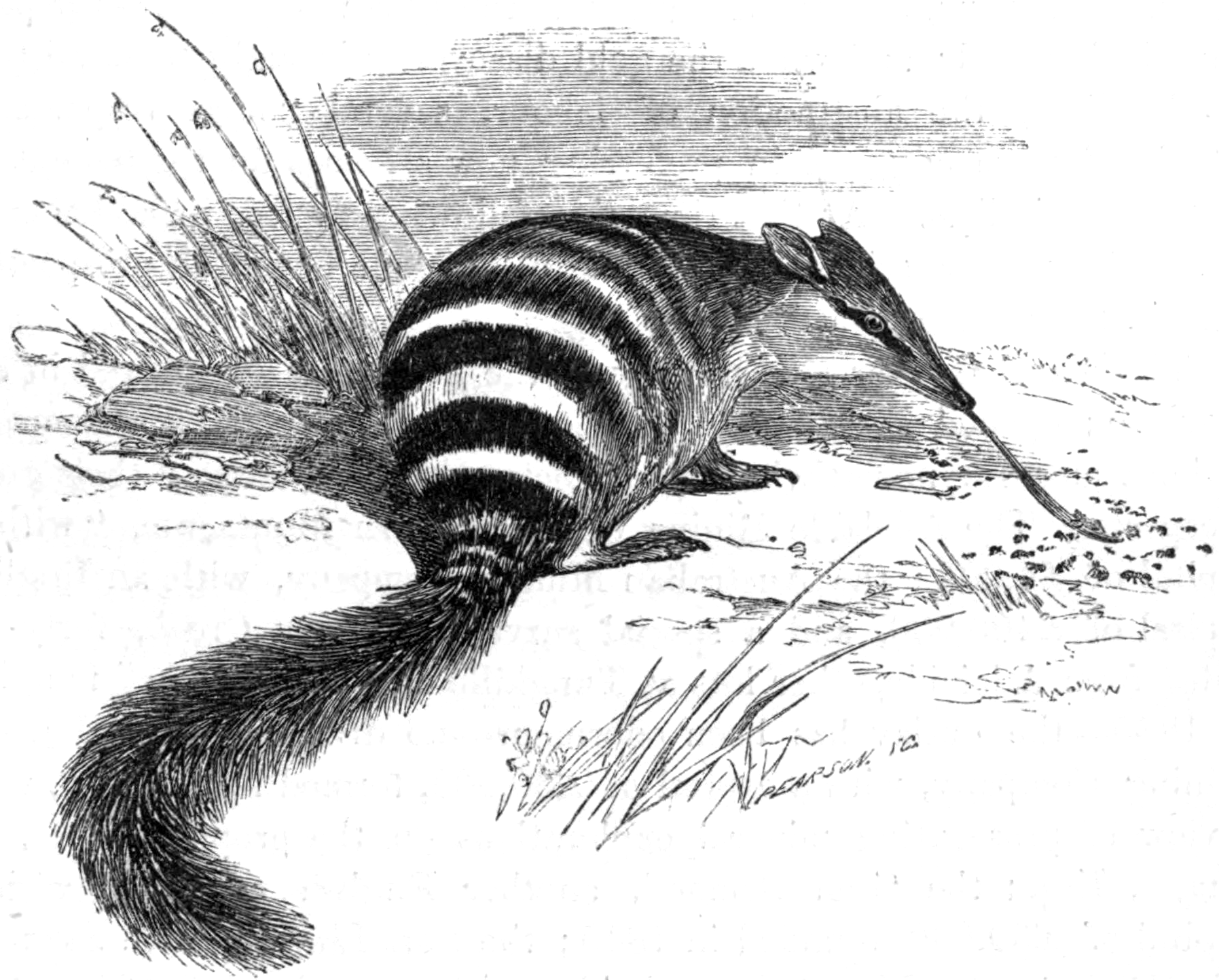
- Numbats are one of only two marsupials active strictly during the day (diurnal) - the other is the Musky Rat Kangaroo in Queensland. Most marsupials are nocturnal or crepuscular.
- Numbats, along with other dasyurids (carnivorous marsupials) are special in that they don't have proper pouches, just a fold of skin to cover the suckling young.
Aboriginal Culture
To the Pitjantjatjarra people in the area around the NT/WA/SA border, the numbat (walpurti/walputi) painted the spots on the large lizard Ngintaka, or Perentie (Varanus giganteus), during the Dreamtime, and in return, the Ngintaka painted Walpurti’s distinctive stripes.
Bryce, Suzy. & Institute for Aboriginal Development (Alice Springs, N.T.). 1997, Women's gathering and hunting in the Pitjantjatjara homelands / compiled by Suzy Bryce IAD Press Alice Springs, N.T
Recent Research
- Dr Tony Friend with the Numbat Task Force are using radio collars to understand numbat behaviour following successful efforts to protect them from feral cats
- Numbats' fur isn't only magnificent to look at, it's great for keeping the tiny creatures warm. They have a sparse outer coat and dense inner coat that helps them conserve energy by retaining solar heat at one of the highest rates of any mammal. https://doi.org/10.1002/cphy.c110055
Resources
Watch the episode on YouTube: https://youtu.be/5WsNaGAThp8
Lineart coming soon!
Links
- http://www.numbat.org.au/thenumbat/ and Fact Sheet
- Perth zoo https://perthzoo.wa.gov.au/animal/numbat
- Atlas of Living Australia https://bie.ala.org.au/species/https://biodiversity.org.au/afd/taxa/6c72d199-f0f1-44d3-8197-224a2f7cff5f
- Australian Geographic https://www.australiangeographic.com.au/fact-file/numbat/ and https://www.australiangeographic.com.au/topics/wildlife/2021/07/the-plight-of-the-numbat/
- DBCA Fact sheet
- Australian Wildlife Conservancy https://www.australianwildlife.org/wildlife/numbat/
- WWF https://www.wwf.org.au/what-we-do/species/numbat#gs.pj31s9
Discussion & Questions
Please share your thoughts below! Members can comment directly on posts.
- Do you have an interesting observation, story or fact to share about numbats? Or a question you would like to know the answer to?
- Have you nature journaled a numbat or your faunal emblem? I’d love to see it! Tag me @kims.art.adventures with #NJWM_emblems

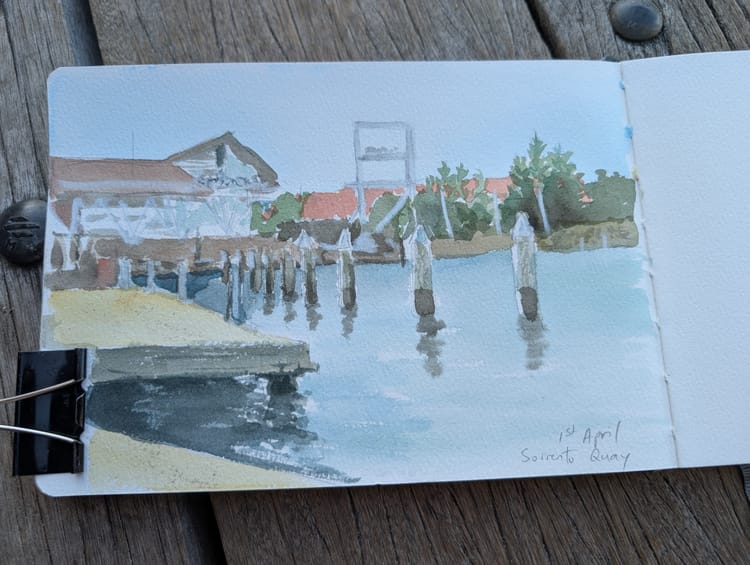
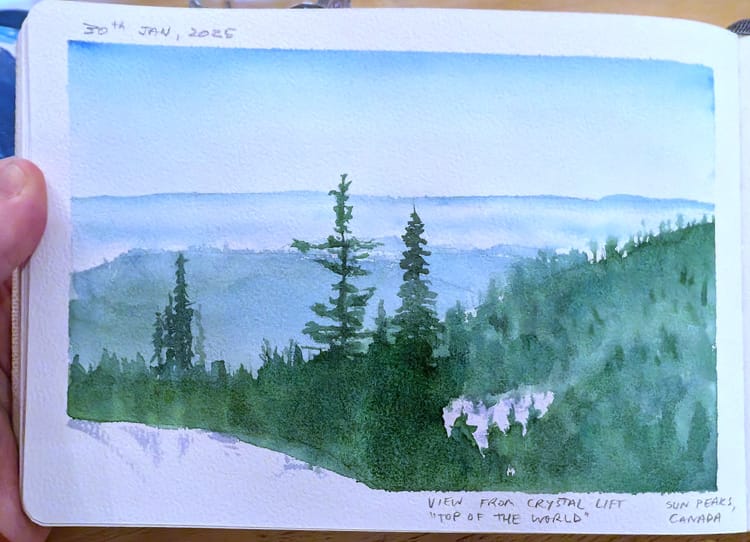
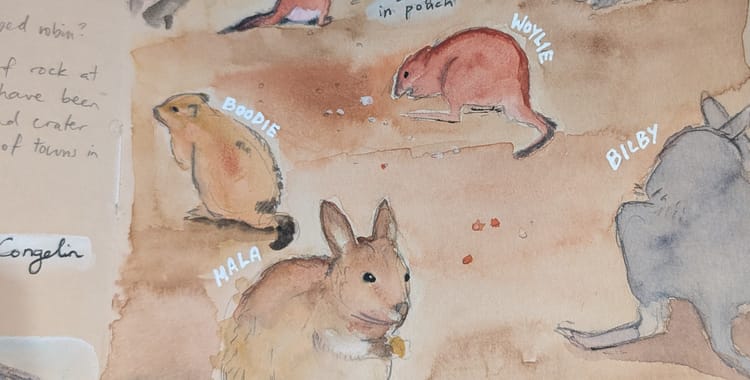
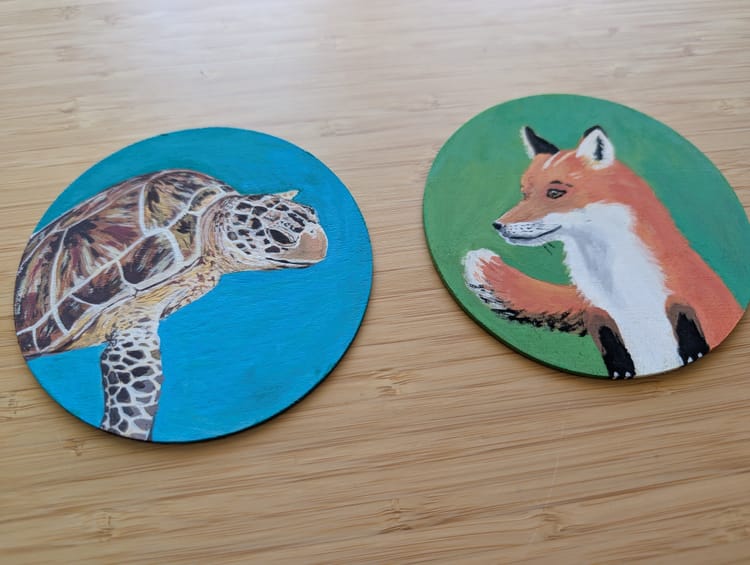
Member discussion